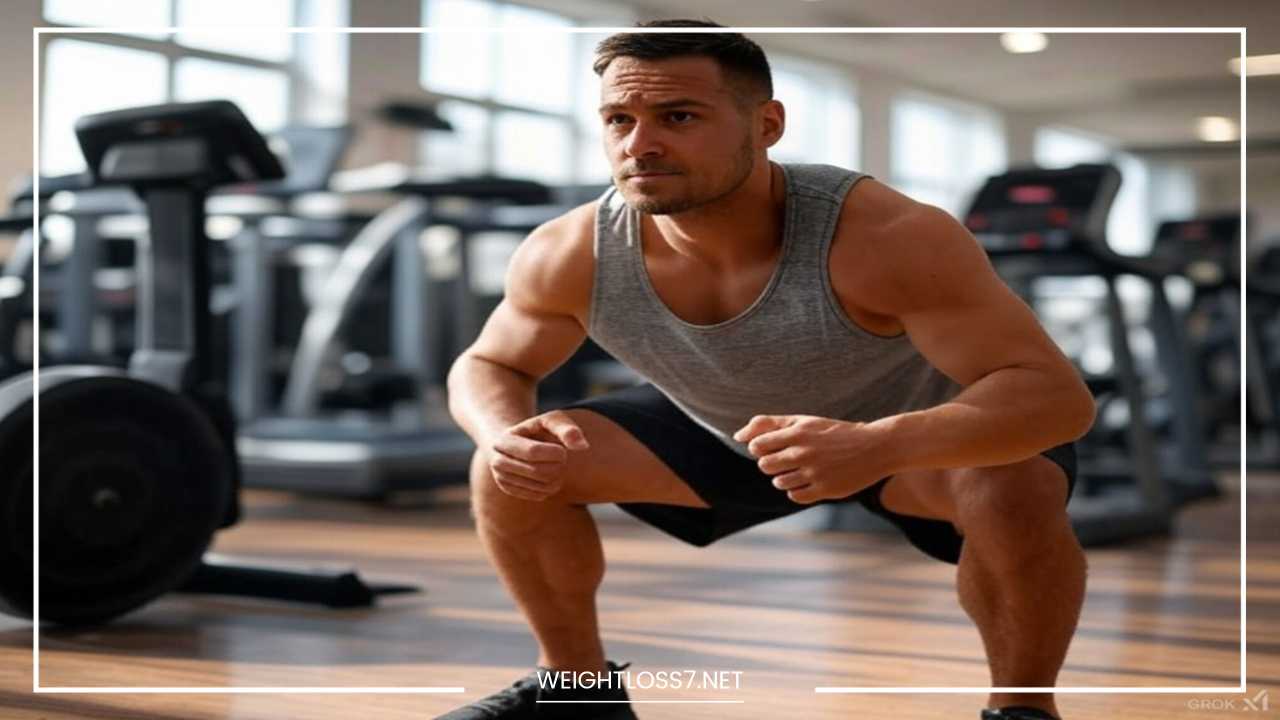HIIT Exercises for Men

HIIT Exercises for Men
HIIT Exercises for Men: A Comprehensive Guide to Unleashing Your Fitness Potential
High-Intensity Interval Training (HIIT) has become one of the most popular and effective exercise methodologies in the modern fitness landscape.
Its versatility, time-efficiency, and proven results have made it a go-to workout for those looking to maximize their physical performance without committing to long hours at the gym.
For men who want to get the most out of their fitness efforts, HIIT provides a powerful solution to boost cardiovascular health, build muscle, burn fat, and enhance athletic performance.
This guide explores the science behind HIIT, outlines its many benefits for men, and provides actionable strategies and workout examples to help you unlock your fitness potential.
What is HIIT?
High-Intensity Interval Training (HIIT) is a form of exercise that alternates between intense bursts of activity and periods of low-intensity recovery or rest.
HIIT workouts are typically shorter in duration compared to traditional steady-state cardio workouts, yet they provide superior results in terms of fat burning, cardiovascular health, and muscle endurance.
Unlike traditional exercises that involve long periods of moderate exertion, HIIT takes advantage of the body’s ability to push itself to the limit during brief, intense intervals.
These high-intensity bursts push the body to work at near maximum capacity for short durations, followed by recovery periods where you can catch your breath before the next round.
This interval-based approach has been proven to stimulate various physiological responses that lead to increased metabolism, muscle gains, and fat loss.
The key factor that makes HIIT so effective is its ability to work both the aerobic and anaerobic energy systems, thereby improving overall fitness in a balanced and holistic manner.
Understanding the Science Behind HIIT
HIIT works on several physiological levels to produce exceptional fitness results. Below are some of the primary mechanisms that make HIIT so effective for men:
1. EPOC (Excess Post-exercise Oxygen Consumption)
One of the key benefits of HIIT is the phenomenon known as Excess Post-exercise Oxygen Consumption (EPOC).
After completing a high-intensity interval, your body enters a recovery phase where it continues to burn calories at an elevated rate for several hours, even after the workout is over.
This is due to the oxygen debt created during the intense exercise, which the body needs to repay to return to its resting state.
As a result, the metabolic rate remains elevated for hours, contributing to continuous fat burning. This afterburn effect makes HIIT an efficient workout for fat loss.
2. Hormonal Response and Testosterone Production
Another reason HIIT is so effective for men is its ability to stimulate the release of key hormones that are crucial for muscle growth, fat loss, and overall health.
One of the most significant hormonal responses to HIIT is an increase in testosterone production.
Testosterone is vital for men because it supports muscle growth, bone density, and fat metabolism. HIIT’s intense nature leads to spikes in testosterone levels, which can help men build lean muscle mass, improve recovery, and enhance overall vitality.
Moreover, HIIT also triggers the release of growth hormone, which aids in fat loss, muscle repair, and cellular regeneration.
Both testosterone and growth hormone have synergistic effects when combined with proper nutrition and strength training, making HIIT an effective tool for muscle building and body composition improvement.
3. Enhanced Insulin Sensitivity
HIIT has been shown to improve insulin sensitivity, meaning the body becomes more efficient at using insulin to regulate blood sugar levels.
This has a profound impact on overall metabolic health and reduces the risk of developing insulin resistance or type 2 diabetes.
For men, better insulin sensitivity means more effective utilization of carbohydrates for energy during workouts, better nutrient absorption, and improved fat-burning capabilities.
4. Mitochondrial Biogenesis
HIIT promotes mitochondrial biogenesis—the process by which the number and efficiency of mitochondria (the energy-producing structures in your cells) increase.
Mitochondria play a critical role in energy production and endurance. By increasing mitochondrial density, HIIT improves your body’s ability to produce energy, enhances aerobic capacity, and boosts stamina.
Over time, this leads to significant improvements in cardiovascular endurance, helping you to perform at higher intensities for longer durations without fatigue.
5. Cardiovascular Adaptations
HIIT enhances cardiovascular health by increasing stroke volume (the amount of blood pumped by the heart per beat), improving heart efficiency, and increasing oxygen delivery to the muscles.
The heart becomes stronger and more efficient at pumping blood, which can lead to a reduction in resting heart rate over time.
The ability to improve cardiovascular health without dedicating hours to traditional cardio makes HIIT an excellent choice for men who want to enhance both heart health and athletic performance.
Benefits of HIIT for Men
HIIT is more than just a time-saving fitness trend—it offers a wide range of benefits specifically tailored to men’s health, fitness, and performance goals.
1. Time Efficiency
In a world where time is a limited resource, HIIT shines as one of the most time-efficient workout methods.
Traditional steady-state cardio sessions can take upwards of 45 minutes to an hour or more. In contrast, a typical HIIT session lasts between 20 and 30 minutes, allowing you to achieve comparable or even superior results in much less time.
For busy professionals, fathers, and anyone else with a tight schedule, HIIT provides an optimal solution for staying fit without sacrificing time.
2. Fat Loss and Body Composition Improvement
HIIT is highly effective for burning fat and improving body composition. The combination of intense intervals and the afterburn effect encourages the body to burn fat for fuel both during and after the workout.
Moreover, HIIT helps preserve lean muscle mass while simultaneously reducing body fat, leading to a more defined, athletic physique.
Studies have shown that HIIT can reduce both visceral fat (fat around the organs) and subcutaneous fat (fat beneath the skin), both of which contribute to improved health and appearance.
3. Increased Muscle Mass and Strength Gains
While not primarily focused on muscle building, HIIT can stimulate muscle growth and strength, especially when combined with compound exercises such as squats, deadlifts, and push-ups.
The short bursts of intense effort challenge muscles in ways that lead to hypertrophy (muscle growth), especially in the lower and upper body.
Additionally, when paired with strength training, HIIT can enhance strength levels by improving neuromuscular efficiency and enhancing muscle endurance.
4. Cardiovascular Health and Endurance
HIIT is an excellent way to improve cardiovascular endurance. The high-intensity intervals push the heart and lungs to work harder, ultimately leading to enhanced cardiovascular capacity.
Over time, this leads to a stronger heart, lower resting heart rate, and greater oxygen efficiency during physical activity.
For athletes or anyone looking to improve stamina, HIIT is an ideal choice for pushing cardiovascular limits.
5. Enhanced Athletic Performance
HIIT is not just a fat-burning workout; it can also enhance athletic performance in various sports.
The explosive nature of HIIT intervals helps improve power, agility, and explosiveness, which are key components for performance in sports such as sprinting, football, basketball, and martial arts.
Moreover, the strength and endurance benefits translate into better overall athletic performance, whether on the field, court, or track.
6. Increased Testosterone Levels
Testosterone is crucial for muscle building, fat loss, and overall health in men. HIIT has been shown to increase testosterone levels, providing an added benefit for men looking to optimize their hormone levels.
Elevated testosterone levels can contribute to greater muscle mass, increased libido, better mood, and enhanced overall energy levels.
7. Mental and Emotional Well-being
HIIT is not just physically beneficial; it also has positive effects on mental and emotional health. The intensity of HIIT workouts triggers the release of endorphins—neurotransmitters that boost mood and reduce stress.
Additionally, completing a challenging HIIT workout provides a sense of accomplishment and confidence.
For men who may struggle with stress, anxiety, or depression, incorporating HIIT into their routine can be an effective tool for boosting mental health.
8. Variety and Adaptability
HIIT is a versatile training method that can be adapted to suit any fitness level or goal. Whether you’re a beginner or an advanced athlete, HIIT can be modified in terms of intensity, duration, and exercise selection.
This adaptability keeps workouts fresh, engaging, and progressive, preventing plateaus and ensuring continual improvement.
Creating Your Ideal HIIT Workout
Crafting an effective HIIT workout requires careful planning to ensure that it meets your specific goals while challenging you appropriately. Below are some key considerations to keep in mind when designing your HIIT routine:
1. Warm-Up (5-10 minutes)
A proper warm-up is essential to prepare your muscles and joints for the intense work ahead. Start with light cardio, such as jogging, cycling, or jumping jacks.
Follow this with dynamic stretches such as arm circles, leg swings, and torso twists. This helps to increase blood flow, improve mobility, and reduce the risk of injury during high-intensity intervals.
2. Exercise Selection
Choose a combination of exercises that target different muscle groups. Compound movements (like squats, lunges, and push-ups) engage multiple muscle groups and are great for building strength and muscle mass.
Isolation exercises (such as bicep curls and triceps extensions) can also be incorporated to target specific muscles. Make sure to vary exercises to maintain interest and challenge the body in different ways.
3. Interval Structure
The key to HIIT is the alternation between intense effort and recovery. The most common interval ratio is 2:1 (e.g., 30 seconds of work followed by 15 seconds of rest).
Beginners may start with a 1:1 or even a 1:2 ratio (e.g., 30 seconds of work and 30-60 seconds of rest), gradually increasing the intensity and reducing rest time as fitness improves.
4. Number of Rounds
The number of rounds you perform in a HIIT workout depends on your fitness level and the duration of your workout.
Beginners can start with 2-3 rounds, while more advanced individuals may perform 4-5 rounds or more. Gradually increase the number of rounds and exercise duration as your endurance improves.
5. Cool-Down (5-10 minutes)
Finish your workout with a cool-down that includes light cardio and static stretching. Hold each stretch for 20-30 seconds to improve flexibility and promote muscle recovery.
This will also help to bring your heart rate back to its resting level and prevent dizziness or muscle stiffness.
Sample HIIT Workouts for Men
Below are several sample HIIT workouts tailored to different fitness levels. Each workout emphasizes different fitness goals—whether fat loss, muscle gain, or cardiovascular improvement.
Beginner HIIT Workout (20 minutes)
- Warm-up (5 minutes): Light jogging or cycling
- Exercise Circuit:
- Squats (30 seconds)
- Push-ups (30 seconds)
- Lunges (30 seconds)
- Plank (30 seconds)
- Jumping Jacks (30 seconds)
- Rest: 15 seconds between exercises
- Rounds: 2
- Cool-down (5 minutes): Static stretching
Intermediate HIIT Workout (25 minutes)
- Warm-up (5 minutes): Light cardio and dynamic stretches
- Exercise Circuit:
- Burpees (45 seconds)
- Mountain Climbers (45 seconds)
- Dumbbell Thrusters (45 seconds)
- Kettlebell Swings (45 seconds)
- Renegade Rows (45 seconds)
- Rest: 30 seconds between exercises
- Rounds: 3
- Cool-down (5 minutes): Static stretching
Advanced HIIT Workout (30 minutes)
- Warm-up (5 minutes): Light cardio and mobility exercises
- Exercise Circuit:
- Sprinting (30 seconds)
- Rest (15 seconds)
- Deadlifts (60 seconds)
- Overhead Press (60 seconds)
- Pull-ups (60 seconds)
- Box Jumps (60 seconds)
- Rest: 30 seconds between exercises
- Rounds: 3
- Cool-down (5 minutes): Static stretching
Final Thoughts
HIIT is an incredibly efficient and effective training method that provides a wide range of benefits for men, including fat loss, muscle building, cardiovascular health, and improved athletic performance.
By understanding the science behind HIIT and incorporating it into your fitness routine, you can achieve rapid, sustainable results while saving time.
Whether you are a beginner or an advanced athlete, HIIT can be adapted to suit your needs and goals, making it an invaluable tool for any fitness regimen.
By following the guidelines outlined in this guide and staying consistent with your training, you can unlock your full fitness potential and achieve the results you’ve always desired.

















